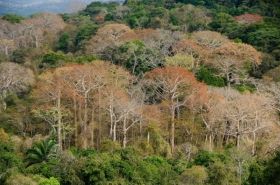Researchers at the Smithsonian Tropical Research Institute (STRI) resolved this apparent contradiction, showing that phosphorus limits the growth of individual tree species but not entire forest communities. Their results, published online in Nature, March 8, have sweeping implications for understanding forest growth and change.
Vast areas of the tropics occur on old landscapes where rock-derived nutrients have been leached away by years of heavy rainfall. Phosphorus is particularly scarce, because the iron oxides that give tropical soils their characteristic red color bind to the phosphorus, making it unavailable to plants. However, the addition of fertilizer to diverse forests in Africa, Southeast Asia and the Americas has not increased tree growth. The only place where fertilization resulted in increased tree growth was in Hawaii, where the forest is dominated by a single tree species.
An alternative way to study nutrient limitation is by comparing the growth rates of trees in forests that naturally differ in soil nutrient availability: the tiny but highly biodiverse tropical country of Panama provides a perfect setting for this.
Continue reading at Smithsonian Tropical Research Institute
Image via Smithsonian Tropical Research Institute


